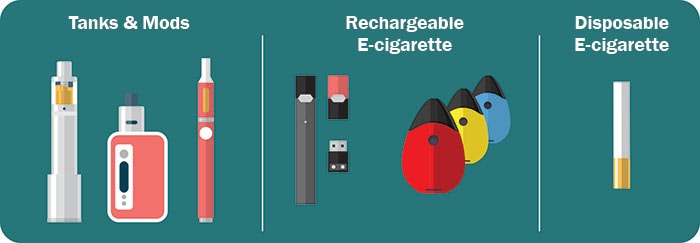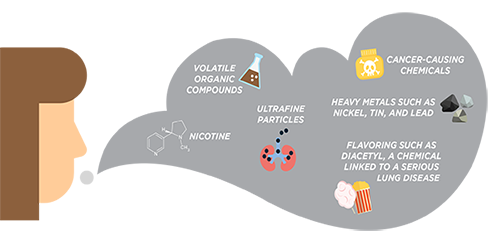
Privacy statement: Your privacy is very important to Us. Our company promises not to disclose your personal information to any external company with out your explicit permission.
E-cigarettes are not safe for youth, young adults, and pregnant women, as well as adults who do not currently use tobacco products.

Some e-cigarettes are made to look like regular cigarettes, cigars, or pipes.
Some resemble pens, USB sticks, and other everyday items.
The e-cigarette aerosol that users breathe from the device and exhale can contain harmful and potentially harmful substances, including:
It is difficult for consumers to know what e-cigarette products contain. For example, some e-cigarettes marketed as containing zero percent nicotine have been found to contain nicotine.2
What is in e-cigarette aerosol?

Most e-cigarettes contain nicotine, which is addictive and toxic to developing fetuses. Nicotine exposure can also harm adolescent and young adult brain development, which continues into the early to mid-20s.1 E-cigarette aerosol can contain chemicals that are harmful to the lungs. And youth e-cigarette use is associated with the use of other tobacco products, including cigarettes.
For more information about the risks of e-cigarettes for young people, visit Quick Facts on the Risks of E-cigarettes for Kids, Teens, and Young Adults.

Yes-but that doesn`t mean e-cigarettes are safe. E-cigarette aerosol generally contains fewer toxic chemicals than the deadly mix of 7,000 chemicals in smoke from regular cigarettes.3 However, e-cigarette aerosol is not harmless. It can contain harmful and potentially harmful substances, including nicotine, heavy metals like lead, volatile organic compounds, and cancer-causing agents.1

E-cigarettes are not currently approved by the FDA as a quit smoking aid. The U.S. Preventive Services Task Force, a group of health experts that makes recommendations about preventive health care, has concluded that evidence is insufficient to recommend e-cigarettes for smoking cessation in adults, including pregnant adults.3

However, e-cigarettes may help non-pregnant adults who smoke if used as a complete substitute for all cigarettes and other smoked tobacco products.
E-cigarettes are the most commonly used tobacco product among youth.
LET'S GET IN TOUCH

Privacy statement: Your privacy is very important to Us. Our company promises not to disclose your personal information to any external company with out your explicit permission.

Fill in more information so that we can get in touch with you faster
Privacy statement: Your privacy is very important to Us. Our company promises not to disclose your personal information to any external company with out your explicit permission.